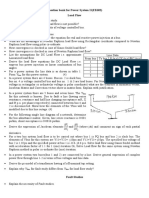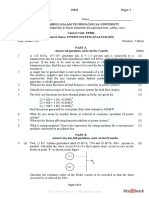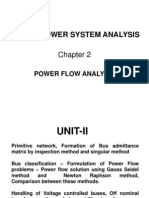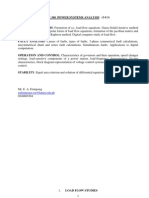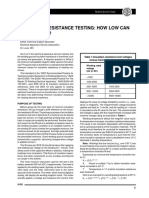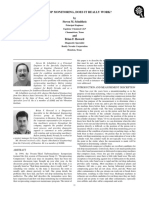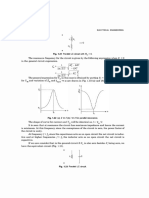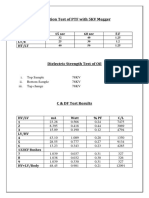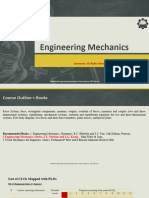Lecture 5 - Load Flow Solutions
Uploaded by
12onn1eLecture 5 - Load Flow Solutions
Uploaded by
12onn1eSolution of the Load Flow Problem
Load flow solutions in power networks are solved to answer the following questions.
- What are the line transformer and generator loads
- What are the voltage levels throughout the system
- What are the effects of changes to the system
- Can a balanced steady state be reached
Power systems can not be modelled by the conventional circuit loop or nodal analysis
methods as loads are given in terms of complex powers and in steady state the
generators can be considered to be power sources. In general the load VARS (P
L
and
Q
L
) are known and some generator VARS (P
G
and Q
G
) are known and so a solution is
sought for the transmission and the remainder generator VARS (there must be at least
one unknown generator VAR in the system).
The problem is basically that of solving 2n non-linear algebraic equations for an n bus
system and therefore requires numerical analysis techniques. The standard techniques
used are:
- Gauss- Siedel
- Newton-Raphson
The Newton-Raphson technique is more popular as it is more computationally
efficient.
Figure 1 shows an example 4 bus system with four generators and loads linked by a
transmission network. The impedances shown are due to component impedances such
as transformers, transmission lines and generators.
Figure 1 Example 4 bus network
Z
1,2
= 1/Y
1,2
Z
1,3
= 1/Y
1,3
Z
3,4
= 1/Y
3,4
Z
2,4
= 1/Y
2,4
S
G1
, S
L1
, V
1
S
G2
, S
L2
, V
2
S
G3
, S
L3
, V
3
S
G4
, S
L4
, V
4
I
1
I
2
I
4
I
3
Basic Considerations
Transmission lines are passive and can be treated either as admittances or impedances
using n port network theory. The admittance approach has been found to be the more
suitable for the power flow problem. In the admittance approach the transmission
currents at the nodes are given by the node voltages and transmission system
admittances as:
| |
t n
= ( (
I Y V
(1)
where V
n
are the nodal voltage phasors ( =V
n
n
) and [Y] is the bus admittance
matrix (=Y ) the elements of [Y] are given by:
Diagonal elements of the matrix:
y
i,i
= all admittances connected to node i
(e.g y
11
= Y
1
+Y
1,2
+ Y
1,3
for Fig.1.)
Off diagonal elements of the matrix:
y
i,j
= - admittances connected directly between nodes i and j
(e.g y
1,2
= -Y
1,2
for Fig.1.)
Example
Figure 2 example system where all parameters are in per unit quantities
For the example system given in Figure 2. the following bus admittance matrix can be
constructed
| |
50 100 100 50 0
100 100 100 0 100
50 0 100 50 100
0 100 100 100 100
Y j
+ (
(
+
(
=
( +
(
+
Z
1,2
= j0.01
Z
1,3
= j0.02
Z
3,4
= j0.01
Z
2,4
= j0.01
1
1 1 = Z V
o
2
1 1 = Z V
o
3
1 0 = Z V
o
4
1 0 = Z V
o
I
1
I
2
I
4
I
3
The bus currents are then given by
| |
1
180
1
180
0.873 0.5
150 100 50 0 1
100 200 0 100 1.745 0.5
1
50 0 150 100
0.873 0.5
1
0 100 100 200
1.745 0.5
1
(
(
Z
( (
(
( (
Z (
( (
= =
(
( (
Z
(
( (
(
(
Z
(
I
j
o
o
j
o
o
e
j
e
t
t
Consider the currents at a node i as shown in Figure 3.
Figure 3. Fundamental node i or bus on a transmission system (subscripts
G=generation, T=transmission and L = load)
From Kirchhoffs current law we have
Gi Li Ti
= + I I I
(2)
or we can also write
* * *
Gi Li Ti
= + I I I
(3)
Multiplying by the bus voltage V
i
gives
* * *
Gi Li Ti
i i i
= + VI VI VI
(4)
Equation (4) is just the power balance equation which can be expressed as
Gi Li Ti
= + S S S
(5)
Splitting equation (5) into real and reactive parts gives
Gi Li Ti
P P P = +
(6)
Gi Li Ti
Q Q Q = +
(7)
}I
Ti
Transmission
I
Li
Load
I
Gi
Generation
Bus i
There are then 2 equations which have to be solved and equations (6) and (7) have
potentially 6 unknowns. Thus for a n bus system there could potentially be 6n
unknowns and 2n equations to be solved. In order to be able to solve the equations the
unknowns have to be reduced to 2 unknowns per bus or node.
The transmitted real and reactive power (P
Ti
and Q
Ti
) can be expressed in terms of the
bus voltage phasors (amplitude and phase) as from equation (1) we can put
,
1
n
Ti j
j =
=
i j
I y V
(8)
From equation (8) it then follows that:
,
* * *
1
Ti j
n
Ti i i
j =
= =
i j
S VI V y V
(9)
Or using y = ye
j
we can write
,
,
1
( )
=
= Z
S
i j j
n
Ti i i j i j
j
y VV o o
(10)
Equation 10 can be expressed in terms of real and reactive components as:
,
,
1
cos( )
i j
n
Ti i j i j i j
j
P y VV o o
=
=
(11)
,
,
1
sin( )
i j
n
Ti i j i j i j
j
Q y VV o o
=
=
(12)
Substituting equations (11) and (12) into equations (6) and (7) then reduces the power
flow problem to that of solving the following set of equations at each bus or node on
the system.
,
,
1
cos( )
i j j
n
Gi Li i i j i j
j
P P y VV o o
=
= +
(13)
,
,
1
sin( )
i j j
n
Gi Li i i j i j
j
Q Q y VV o o
=
= +
(14)
In order to solve the equations the number of unknowns have to be reduced to 2 per
bus or node. Normally all the load powers are known and the following table of bus
or node types defines which other unknowns are defined.
Bus Type Unknowns Knowns Approximate number
Slack P
G
and Q
G
V =1 p.u and = 0 At least 1
Load V and P
G
and Q
G
85%
Generator Q
G
and P
G
and V 15%
The slack bus is the reference bus which is normally set to have a voltage magnitude
of 1 p.u. and zero voltage phase angles. All other phase angles are with respect to the
slack bus phase angle. The slack bus has also undefined generation so that any
mismatch between supply and loss (losses can not be predicted before a solution is
known) can be absorbed in the slack bus for a solution to be found. The power losses
can be distributed between several generators and this is known as a distributed slack
bus. There are then 2n unknown and 2n equations to be solved in a n bus system and a
solution is then sought for all the unknown variables.
You might also like
- Q LearningEmbeddedSineCosineAlgorithmQLESCANo ratings yetQ LearningEmbeddedSineCosineAlgorithmQLESCA53 pages
- Reference Manual of Dynamic Voltage Stability PDFNo ratings yetReference Manual of Dynamic Voltage Stability PDF370 pages
- Power System Security: Contingency AnalysisNo ratings yetPower System Security: Contingency Analysis24 pages
- EEE 458 - Power System Protection LaboratoryNo ratings yetEEE 458 - Power System Protection Laboratory12 pages
- Simulation of Some Power System, Control System and Power Electronics Case Studies Using Matlab and PowerWorld SimulatorFrom EverandSimulation of Some Power System, Control System and Power Electronics Case Studies Using Matlab and PowerWorld SimulatorNo ratings yet
- Unbalanced Three-Phase Distribution SystemNo ratings yetUnbalanced Three-Phase Distribution System5 pages
- New Contributions To Load Flow Studies by The Method of Reduction and RestorationNo ratings yetNew Contributions To Load Flow Studies by The Method of Reduction and Restoration7 pages
- Voltage Stability in Electrical Power Systems100% (1)Voltage Stability in Electrical Power Systems33 pages
- Protection: Figure 4-27: Protection Display HierarchyNo ratings yetProtection: Figure 4-27: Protection Display Hierarchy29 pages
- Reactive Power Management and Voltage Stability100% (1)Reactive Power Management and Voltage Stability32 pages
- In The Name of The Most Beneficent & The Most Merciful: Radio and TV Antenna 1100% (1)In The Name of The Most Beneficent & The Most Merciful: Radio and TV Antenna 142 pages
- Question Bank Samples For Power System II EE602No ratings yetQuestion Bank Samples For Power System II EE6024 pages
- 3-2 Analysis of A Power System in Per Unit: StepsNo ratings yet3-2 Analysis of A Power System in Per Unit: Steps9 pages
- A Guide For P.S. Design Project Spring 2014 PDFNo ratings yetA Guide For P.S. Design Project Spring 2014 PDF84 pages
- 4 Teaching Notes - Maxima Minima Points of Inflection ConcavityNo ratings yet4 Teaching Notes - Maxima Minima Points of Inflection Concavity13 pages
- Overcurrent Protection - Time and Current GradingNo ratings yetOvercurrent Protection - Time and Current Grading5 pages
- Bus Impedance Matrix in Faults CalculationsNo ratings yetBus Impedance Matrix in Faults Calculations38 pages
- ECE 476 Power System Analysis: Lecture 11: Ybus, Power FlowNo ratings yetECE 476 Power System Analysis: Lecture 11: Ybus, Power Flow32 pages
- 2018 April Power Systems Analysis - EE306-A - Ktu QbankNo ratings yet2018 April Power Systems Analysis - EE306-A - Ktu Qbank3 pages
- Sheet (8) Synchronous Machine Problem (1) :: SolutionNo ratings yetSheet (8) Synchronous Machine Problem (1) :: Solution5 pages
- Implementation of The Sine - Cosine Algorithm To The Pressure Vessel Design ProblemNo ratings yetImplementation of The Sine - Cosine Algorithm To The Pressure Vessel Design Problem6 pages
- EEL303: Power Engineering I - Tutorial 7No ratings yetEEL303: Power Engineering I - Tutorial 75 pages
- Power Systems - Basic Concepts and Applications - Part I: Pdhonline Course E104 (12 PDH)No ratings yetPower Systems - Basic Concepts and Applications - Part I: Pdhonline Course E104 (12 PDH)21 pages
- Project Assignment: Power System Simulation For Engineers (PSS/E Version 34)No ratings yetProject Assignment: Power System Simulation For Engineers (PSS/E Version 34)12 pages
- Lecture 8 - Example Sequence Networks and Asymmetric FaultsNo ratings yetLecture 8 - Example Sequence Networks and Asymmetric Faults2 pages
- Experiment.3. Load Characteristics of D.C Shunt Generator100% (1)Experiment.3. Load Characteristics of D.C Shunt Generator2 pages
- Math Model Wire Feeding GMAW 05-2003-PADILLA-sNo ratings yetMath Model Wire Feeding GMAW 05-2003-PADILLA-s10 pages
- Sin 90 1 - (I) : Magnetic Field at Any Point On The Axis of A Circular Coil Carrying CurrentNo ratings yetSin 90 1 - (I) : Magnetic Field at Any Point On The Axis of A Circular Coil Carrying Current1 page
- Chapter 3 Fluid Statics: CN2122 / CN2122ENo ratings yetChapter 3 Fluid Statics: CN2122 / CN2122E25 pages
- Annual Lesson Plan Science Form 2: Semester Weeks TopicsNo ratings yetAnnual Lesson Plan Science Form 2: Semester Weeks Topics4 pages
- Basic Electrical Engineering (PDFDrive) (099-100)No ratings yetBasic Electrical Engineering (PDFDrive) (099-100)2 pages
- Superposition Method in Circuit Analysis Prepared by Engr. A.C.PatricioNo ratings yetSuperposition Method in Circuit Analysis Prepared by Engr. A.C.Patricio6 pages
- Physics 221 Sec. 500 Optical and Thermal Physics Spring 2017No ratings yetPhysics 221 Sec. 500 Optical and Thermal Physics Spring 201721 pages
- Insulation Test of PTF With 5KV Megger: 15 Sec 60 Sec F.F Ht/E Lt/E HT/LTNo ratings yetInsulation Test of PTF With 5KV Megger: 15 Sec 60 Sec F.F Ht/E Lt/E HT/LT5 pages
- IPS-EnERGY Available Relay Models - April 2010No ratings yetIPS-EnERGY Available Relay Models - April 201018 pages
- Simulation of Some Power System, Control System and Power Electronics Case Studies Using Matlab and PowerWorld SimulatorFrom EverandSimulation of Some Power System, Control System and Power Electronics Case Studies Using Matlab and PowerWorld Simulator
- New Contributions To Load Flow Studies by The Method of Reduction and RestorationNew Contributions To Load Flow Studies by The Method of Reduction and Restoration
- Protection: Figure 4-27: Protection Display HierarchyProtection: Figure 4-27: Protection Display Hierarchy
- In The Name of The Most Beneficent & The Most Merciful: Radio and TV Antenna 1In The Name of The Most Beneficent & The Most Merciful: Radio and TV Antenna 1
- 4 Teaching Notes - Maxima Minima Points of Inflection Concavity4 Teaching Notes - Maxima Minima Points of Inflection Concavity
- ECE 476 Power System Analysis: Lecture 11: Ybus, Power FlowECE 476 Power System Analysis: Lecture 11: Ybus, Power Flow
- 2018 April Power Systems Analysis - EE306-A - Ktu Qbank2018 April Power Systems Analysis - EE306-A - Ktu Qbank
- Sheet (8) Synchronous Machine Problem (1) :: SolutionSheet (8) Synchronous Machine Problem (1) :: Solution
- Implementation of The Sine - Cosine Algorithm To The Pressure Vessel Design ProblemImplementation of The Sine - Cosine Algorithm To The Pressure Vessel Design Problem
- Power Systems - Basic Concepts and Applications - Part I: Pdhonline Course E104 (12 PDH)Power Systems - Basic Concepts and Applications - Part I: Pdhonline Course E104 (12 PDH)
- Project Assignment: Power System Simulation For Engineers (PSS/E Version 34)Project Assignment: Power System Simulation For Engineers (PSS/E Version 34)
- Computer Aided Design of Electrical MachinesFrom EverandComputer Aided Design of Electrical Machines
- Lecture 8 - Example Sequence Networks and Asymmetric FaultsLecture 8 - Example Sequence Networks and Asymmetric Faults
- Experiment.3. Load Characteristics of D.C Shunt GeneratorExperiment.3. Load Characteristics of D.C Shunt Generator
- Sin 90 1 - (I) : Magnetic Field at Any Point On The Axis of A Circular Coil Carrying CurrentSin 90 1 - (I) : Magnetic Field at Any Point On The Axis of A Circular Coil Carrying Current
- Annual Lesson Plan Science Form 2: Semester Weeks TopicsAnnual Lesson Plan Science Form 2: Semester Weeks Topics
- Superposition Method in Circuit Analysis Prepared by Engr. A.C.PatricioSuperposition Method in Circuit Analysis Prepared by Engr. A.C.Patricio
- Physics 221 Sec. 500 Optical and Thermal Physics Spring 2017Physics 221 Sec. 500 Optical and Thermal Physics Spring 2017
- Insulation Test of PTF With 5KV Megger: 15 Sec 60 Sec F.F Ht/E Lt/E HT/LTInsulation Test of PTF With 5KV Megger: 15 Sec 60 Sec F.F Ht/E Lt/E HT/LT



























